We’re back in South America on The Bread & Soup Project, and in the country on the continent closest to the majority of the US. It’s a country that I’d venture when most Americans think about it, they think in terms of drug cartels and guerilla fighting. And while there’s no question that those form a part of Colombia, they are more and more a part of its past.
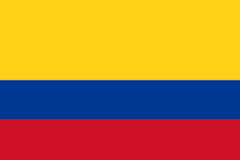 At 548,000 square miles, Colombia would fit comfortably inside Alaska, but at 50 million people, it has 55 times the population – roughly equal to California, Oregon, and Washington combined. Although named for Christopher Columbus, that wasn’t until 1886 – after first being known as Cundinamarca, then the Republic of Granada, and then the Granadine Confederation throughout its colonial and later (1810) independent periods. The country encompasses six geographical and temperate regions, that range from coastal to mountainous to forested areas. The capital is Bogotá, founded in 1538 as the capital of the New Granada viceroyalty (which included Panama, Venezuela, Ecuador and northwest Brazil). Physically it’s about the size of Houston at a little over 600 square miles, with a population of 7.4 million, almost three times that of Houston.
At 548,000 square miles, Colombia would fit comfortably inside Alaska, but at 50 million people, it has 55 times the population – roughly equal to California, Oregon, and Washington combined. Although named for Christopher Columbus, that wasn’t until 1886 – after first being known as Cundinamarca, then the Republic of Granada, and then the Granadine Confederation throughout its colonial and later (1810) independent periods. The country encompasses six geographical and temperate regions, that range from coastal to mountainous to forested areas. The capital is Bogotá, founded in 1538 as the capital of the New Granada viceroyalty (which included Panama, Venezuela, Ecuador and northwest Brazil). Physically it’s about the size of Houston at a little over 600 square miles, with a population of 7.4 million, almost three times that of Houston.
The people are predominately a mix of European white (mostly Spanish descent, though the 20th century saw an influx of Eastern European and Middle Eastern peoples) and “mestizo”, mixed ancestry, about 88%; roughly 7% of African descent, and the balance, 5%, primarily indigenous population. Spanish is the predominate language, with over 99% of the population speaking it. There are 65 Amerindian indigenous and 2 creole languages spoken by enough of the population to be recognized as being regularly in use.
The cuisine is heavily influenced by Spanish traditions as well as some African influence, and of course, the indigenous ingredients and dishes. There are regional differences, “officially” divided into Pacific, Amazonian, Andean, Orinoco, Caribbean, and Insular cuisines. Being one of the world’s most biodiverse countries, there’s a huge natural pantry to choose from.
On to my whimsical project. We’re back to empanadas for our “bread” component, and a version of classic Colombian Empanaditas de Carne or “little meat empanadas”. For the soup, there are many regional differences, though in terms of ubiquity it more or less came down to either some version of an ajiaco or sancocho. My sense is that the latter, in one form or another is more widespread – I could be wrong about that. Picking from regional variations of sancocho was a daunting task, and I ended up, more or less, just picking one – Sancocho Trifásico or literally “three-phase parboil”. Sancochos are traditional soups of both Colombia and Venezuela, with strong roots in stew recipes brought by African slaves, and generally consisting of a simple broth, a variety of starchy vegetables, and often, one or more meats – in the case of this “three-phase”, it refers to three meats. On to the cooking!
I made the filling for the empanaditas first, because then I could leave it to cool while making the dough. We have finely chopped (or ground) beef, diced potato, onion, tomato, bell pepper, finely chopped garlic, green onion, and cilantro, and some salt, pepper, and a some dehydrated chicken or vegetable stock (a modern convenience for this, given that you just need a small amount or stock).
Without showing the step-by-step… Boil the diced potatoes in just enough water to cover, with the stock granules – or in a little stock, you really need only about a cup of broth, so if you have that, go for it. Then drain and mash the potatoes and set aside. Dicing the potatoes allows them to really absorb the flavor from the stock, as well as cook really quickly.
Sauté the onion in a splash of oil for about 5 minutes over low to medium heat. Add the tomato, bell pepper, green onion, garlic, cilantro, salt and pepper, and continue cooking for about 15 minutes, until it becomes a thick paste. Add the meat and cook about 10 minutes until the meat is cooked through and the liquid that comes off of it has evaporated. Then mix this with the mashed potato and set aside to cool.
We have “masarepa”, the same sort of “cornmeal” used to make arepas. It differs from classic cornmeal in that instead of being ground raw, dried corn, it’s parcooked dried corn that’s then redried and ground, so it’s already cooked and takes very little time to then cook the final product, usually an arepa, almost just heating it through. Here it’s mixed with a little salt, some ground saffron, a splash of vegetable oil, and…
…enough water to bring it together in a dough the texture of slightly wet modeling clay. Let that sit for about 10 minutes to make sure the grains of masarepa fully hydrate – it will firm up noticeably.
You may remember a few entries back, on Cape Verde, when I was thinking I should have gone with an easier way to mold the pasteles, which are also not made from wheat flour with gluten to bind them. This is what I should have done – divided the dough up into pieces, this time about the size of a walnut, and place each on a square of plastic wrap. Then a scoop of filling, and use the plastic wrap…
…to fold them over and mold them together into the empanaditas.
They get fried up until golden, about 90 seconds on each side, and they’re ready!
We need an ají, or hot sauce, and a classic of Colombian cuisine is this one made with hot chilies, cilantro (if you don’t like cilantro, use parsley), green onion, tomato, salt, lime juice, and a mix of half and half vinegar and water, just enough to run this through the food processor…
… and get a delicious spoonable hot sauce!
On to our soup, which I actually made beforehand and let sit.
This is one of the easier soups that I’ve made in this project in terms of process, albeit it has a lot of ingredients. We have onion, garlic, bell pepper, yuca, corn, plantain, cilantro (again, parsley for those of you who don’t eat cilantro), small potatoes (or large ones cut in pieces, but a potato that will hold together when cooked a longer time), salt, pepper, and cumin; and we have pork, beef, and chicken, our three-phases.
Blend the aromatic vegetables – the onion, garlic, and bell pepper with the salt, pepper, and cumin and just enough water to create a smooth puree. Put that in your soup pot. Cut the meats into pieces – you can use meats with or without bones – as you can see I went with boneless on the pork and beef, but wings for the chicken, which I just separated into joints. Put those in the pot. Cut the plantain and the corn into rounds, put them in too. Top with water, bring to a boil, reduce heat and simmer for 45 minutes.
Dice the yuca and cut the little potatoes in half (or cube larger ones), top with more water if needed, and cook another 30 minutes.
Add the chopped cilantro, adjust the seasoning if needed (I found it needed more salt). And it’s ready. Sancochos are usually served with a side of rice, but since I’m serving them with empanaditas I didn’t add in yet another starch!
And serve! Make sure everyone gets a little of each kind of vegetable and meat. For those not into hot sauce, empanaditas are also often served with wedges of lime to squirt on them.
Absolutely delicious, especially the empanaditas. And I made enough salsa that I’ve been eating it spooned on to other things over the last couple of days!
Next time we head back to Africa and the country of Comoros, about which, I know absolutely nothing other than that it’s an island somewhere off the southern coast of the continent.
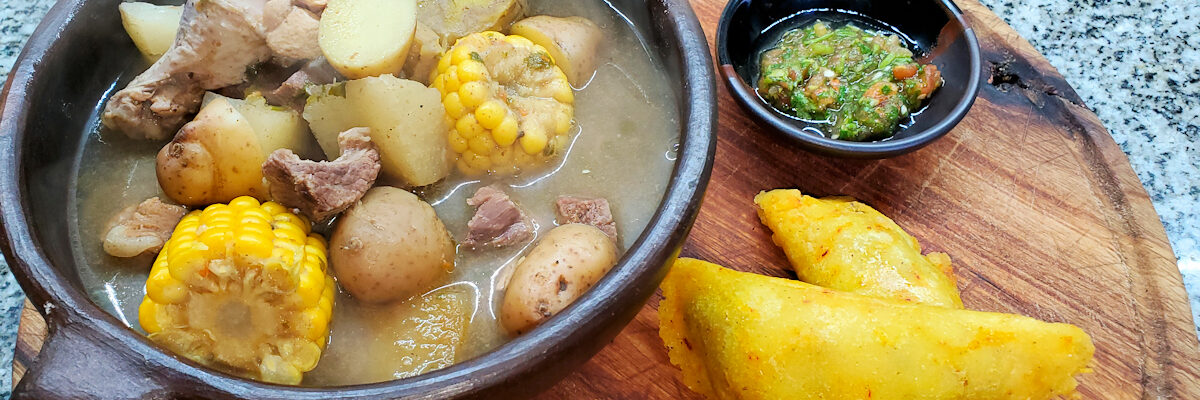
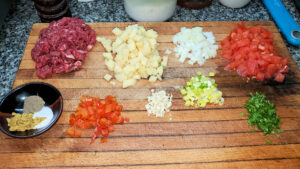
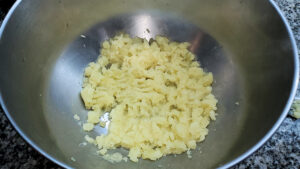
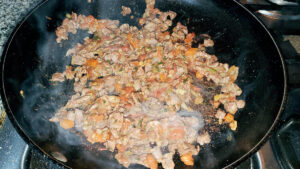
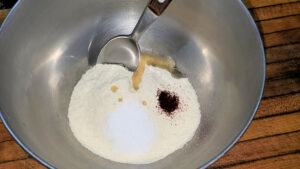
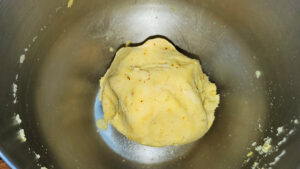
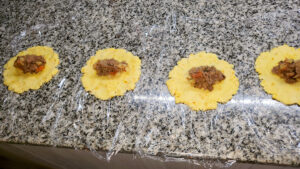
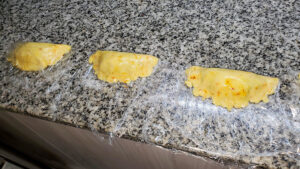
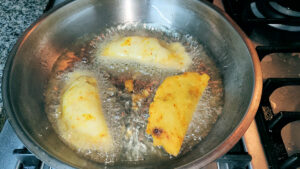
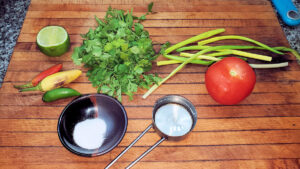
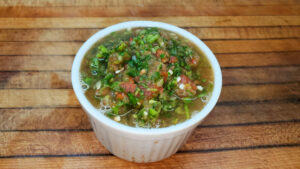
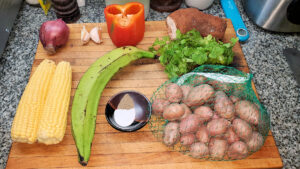
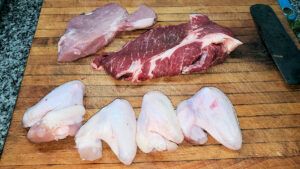
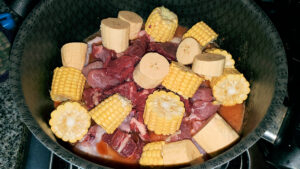
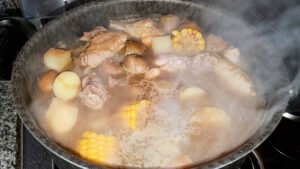
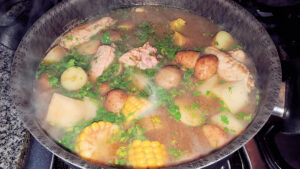
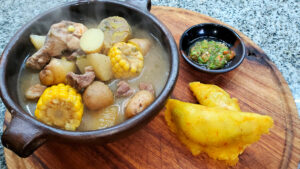
[…] Next time, we’re off to Colombia! […]
Visited Medellin a few years ago. Nice city. Surprising number of Starbucks. Thanks for all the work on this series. Can’t have enough empanadas!
Oh, one can, one can.
[…] soups or ajiaco-sancocho type soups, both of which I’ve made recently in the Costa Rican and Colombian entries. I ended up picking a more unique, if maybe less common, Caldo de camarones, or, shrimp […]